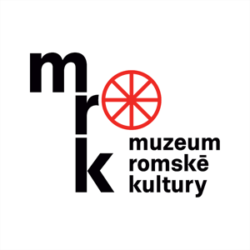Emílie Hanáková
Emílie Hanáková, née Danielová (1924, Dolní Lhota, Zlín district - date of death unknown)
-
Testimony abstract
Emílie Hanáková grew up in Lhota near Luhačovice. Her mother, Anastázie Vlčnovská, was Romani, her biological father was not Romani. Emílie was brought up by her stepfather, Antonín Vlčnovský.
When World War II broke out, Emílie Hanáková was already married [to Otakar Herák] in Luhačovice and had a small child. She believed that if she had still been living with her parents in Lhota, she could have been spared the concentration camp, because the local police inspector Nejezchleba had warned her parents in advance that the Germans were intending to deport them. He even left them their so-called Gypsy identity cards and their father considered fleeing to Slovakia to live with his sister. Eventually, however, they all met up in Uherský Brod in a local farmhouse, which served the Brod and Zlín districts as a reception centre before deportation.
Emílie was arrested on her 19th birthday together with others from the Luhačovice settlement and locked up in the local Sokol Hall. They did not even spare a woman from Pozlovice who had given birth that day. In the early hours of the morning, they were then taken to Uherský Brod on hay wagons. They spent three days there; they all had to wash, but no food was provided. On the day they were to board the railway cars, Hanáková was removed from the transport as being of mixed race, as were her then husband, their common child [name not stated] and another family. She begged a kind gendarme to call her parents, and she gave them all the food she had with her and told them that she was remaining at home.
On their return to Luhačovice, they found the settlement almost razed to the ground, with only one two-roomed house left standing, where the two released families were accommodated. Emílie Hanáková's house had been robbed, and she learned from a woman in the next village that a policeman from Luhačovice had stolen her two new blue buckets. She went to the local gendarmerie station, where she reported it and demanded their return. After two or three days she did receive them back, but she still came into conflict with a local gendarme (whose name was Bednařík or Stolařík), and she said this was why they came for them again, and that time they were deported to Auschwitz with a transport from Hodonín.
Upon arrival at Auschwitz they were tattooed with a registration number, adults on their arms, small children on their calves. The next day they all went to the showers – women, men and children had to stand naked together in a room where they literally bathed in their own sweat, only to be sprinkled with cold water in another room. Emílie added that the young children contracted pneumonia.
She was staying with her family in block eight. On their bunk beds they had only blankets full of lice. In the evening, when they warmed up in the blankets, the lice would become active and Emílie likened it to being thrown into an anthill.
Emílie also described the negative relationships between the prisoners – the omnipresent fear and nervousness. They would even steal from each other. A fellow inmate, Barča, who lived with a Blockältester, stole her clogs, but later returned them. The Blockälteste, a prisoner convicted of murder, was renowned for his sadistic appetites, and often beat prisoners for no reason or when they had displeased the aforementioned Barča.
The food was inadequate; as rations they were given a piece of bread, which never weighed the prescribed 250 grams, plus some shredded thickened beetroot, sometimes a piece of salami or margarine. The water in the camp was dirty and they were afraid to drink even the tea they were given; she said it was probably made of willow leaves or something similar, and people swelled up after it.
When Emílie fell ill with scabies, she was admitted to the infirmary, but they ran out of medicine, so she was just bathed once and then had to lie naked with other naked women under one thin blanket. There were five of them on the bed, and when one turned over, the others had to turn over too. She was treated in this way almost without moving for three weeks. It was similarly taxing when they were inoculated against typhus, because they developed fevers as a reaction to the vaccination; they were unable to go out and just lay there. What saved Emílie was that a fellow inmate was given milk for her baby and she exchanged it with Emílie for her food. The guards then selected the sick on the block and took them to the infirmary. Emílie was also selected; she could barely stand, and walked slowly to the infirmary with the others wrapped in a blanket. But the door closed in her face and no one noticed that she remained standing outside: as a result, she was the only one of the group of dozens of patients to return to the block. The others apparently ended up in the gas chamber. The Jews were burned in the ovens twice a week, on Tuesdays and Fridays, and when they were short of numbers, they also added sick people or Roma.
She also recalled several Romani people who attempted to escape. A Roma from Strážnice[1] was shot and his corpse was then carried around the blocks on a stretcher to deter others; the cousin of Emílie's first husband, was also shot.[2]
Emílie Hanáková's son and father died in Auschwitz, her mother died in Ravensbrück. After a year, Emílie was transferred from Auschwitz to Ravensbrück, where she was pleasantly surprised by the better conditions: they had mattresses, a blue and white blanket and pillow. They they could also wash after work, and there was plenty of water to drink. Next she went to Altenburg, a subsidiary camp of Buchenwald. There was a commandant there who treated them humanely, making sure that the female prisoners got the right rations. Thanks to the diet there, her weight went up from 37 to 50 kilograms by the end of the war. From Altenburg, the women prisoners had to take part in a march. Emílie was liberated by the Americans in Chemnitz.
- [1] After escaping, Jan Kýr left the entire camp complex and was shot on the banks of a river, probably the Vistula. (ed.)
- [2] Jaroslav Herák (born 1915 in Luhačovice) tried to escape twice. After the first attempt, on 27 November 1943, he was imprisoned in a bunker, from where he was assigned to a punishment unit after his release. He tried to escape again, but was shot on 1 February 1944 with two other fellow prisoners. (ed.)
After the war, Emílie Hanáková returned to Luhačovice, where she started working at the Argo Hotel,[1] but she received no wages for her work. So she pleaded her case to the local committee and the chairman [Bedřich] Jahoda started to pay her remuneration from the committee's account. Later she worked for farmers and married a second time.
- [1] The former Argo Hotel, now the Morava Spa House in Luhačovice. (ed.)
-
Origin of Testimony
Jitka Lukešová recorded the survivor's story on 15 July 1987.
-
Where to find this testimony




